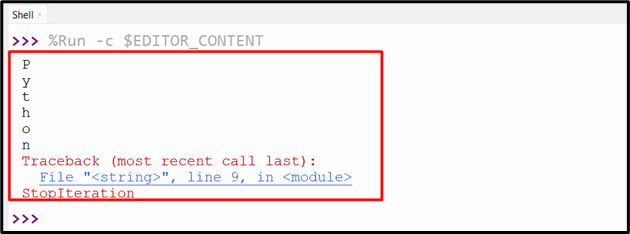Python Next() Function
Python is a versatile language that provides many built-in functions to simplify the coding methodologies such as the “next()” function, which is utilized to iterate over/through the elements of an iterable object. This article will demonstrate how this function works, what it can do, and why it is useful using various examples.
What is the “next()” Function in Python?
Python is an object-oriented programming language used/utilized to create applications, software, and other digital products. The built-in “next()” function is a useful tool that helps to iterate through an iterable object in Python. This guide will explain the “next()” function in detail, including its syntax, parameters, return value, and examples.
Syntax
Parameters
The “next()” function takes the following two parameters:
- The “iterable” parameter is an object that needs to be traversed.
- The “default” parameter is a value that is returned if the iterable has reached its end. If the “default” parameter is not specified, the “StopIteration” exception is raised.
Return Value
The “next()” function displays the next item/element from an iterable object. In the absence of any more elements/items, it raises the “StopIteration” error.
Example 1: Applying the “next()” Function Upon a List
Let’s overview the following example:
my_iter = iter(list_value)
print(next(my_iter))
print(next(my_iter))
print(next(my_iter))
print(next(my_iter))
In the above example:
- The list named “list_value” is created with three elements.
- After that, create an iterator “my_iter” for the list using the “iter()” function.
- Finally, the “next()” function is applied repeatedly to iterate through/over the input list and print/show each item.
- Upon the end of elements/items to be printed, the “StopIteration” exception/error is introduced.
Output

In the above snippet, each item of the list has been displayed using the “next()” function and the discussed exception is raised upon the iteration being completed.
Example 2: Applying the “next()” Function Upon a String
This example illustrates the use of the “next()” function upon a string:
iter_value = iter(string_value)
print(next(iter_value))
print(next(iter_value))
print(next(iter_value))
print(next(iter_value))
print(next(iter_value))
print(next(iter_value))
print(next(iter_value))
Based on the above code, perform the following steps:
- The string named “string_value” is created.
- An iterator name “iter_value” is created for the string that applies the “iter()” function.
- Finally, the “next()” function is implemented repeatedly to iterate through the string and print each string character.
- Likewise, the “StopIteration” exception is raised when there are no more characters to be printed.
Output

In the above snippet, each iterated value is displayed until the last string character is reached.
Example 3: Applying the “next()” Function With a Default Value
Below is an example of utilizing the “next()” function with a default value:
iter_value = iter(list_value)
print(next(iter_value, 0))
print(next(iter_value, 0))
print(next(iter_value, 0))
print(next(iter_value, 0))
In this code block:
- Similarly, the list is initialized and an iterator is created using the “iter()” function.
- The “next()” function iterates through the list and prints each item step by step.
- It is such that when there are no more items to be printed, the default value of “0” is returned.
Output

The above snippet displays the list elements and returns the default value i.e., “0” when no elements are left.
Conclusion
To iterate through an iterable object in Python, we can use the built-in “next()” function. It gives us the next item from the iterable and stops with the “StopIteration” exception when there are no more items left. We can use the “next()” function to easily loop over a list, string, or any other iterable object in Python. This blog demonstrated the usage and working of the “next()” function in Python.